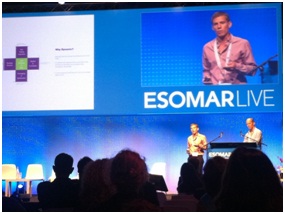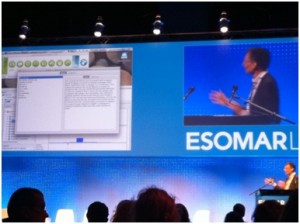With no keynote or welcoming speeches to start Day 2 we kicked off at 9am with Parallel 1 looking at “Impactful Business” and Parallel 2 starting with behavioural ecomomics before moving on to the annual Young Researcher of the Year Award finals.
Click to read more …
[expand title=”Morning Parallel 1 -Impactful Business – Betty Adamou & Elias Veris“]
Betty Adamou
The session opened up with a video showing people from around the world singing and playing instruments to a globally collaborative song of ‘Stand By Me’ which one person tweeted ‘was a nice way to start the day’. Suzana, the session chair, used this video to illustrate her love for music but more so, her excitement when people collaborate and get creative. It set a good tone for the first talk ‘Design Empowered Innovation’ form the guys at Added Value.
 They were saying that at Added Value they encourage creativity however; creativity is not something you schedule. Indeed you might have your best ideas in the shower, at 4am or just at that moment when you’re about to fall asleep. So at Added Value, in their case studies, they showed us how they have harnessed the creativity of their respondents for brands such as Ford, Congac, Levi’s (in particular the Perfect Fit marketing campaign), Hair Dye brands and Lipton Ice Tea. By creating global communities specifically for each of these brands, they were able to understand not just the demographic, but the culture of their demographic from these online communities. One respondent was so engaged with the subject that she even made a video promoting Lipton Ice Tea, as if it were an advertisement and she was actively selling the product.
They were saying that at Added Value they encourage creativity however; creativity is not something you schedule. Indeed you might have your best ideas in the shower, at 4am or just at that moment when you’re about to fall asleep. So at Added Value, in their case studies, they showed us how they have harnessed the creativity of their respondents for brands such as Ford, Congac, Levi’s (in particular the Perfect Fit marketing campaign), Hair Dye brands and Lipton Ice Tea. By creating global communities specifically for each of these brands, they were able to understand not just the demographic, but the culture of their demographic from these online communities. One respondent was so engaged with the subject that she even made a video promoting Lipton Ice Tea, as if it were an advertisement and she was actively selling the product.
During the study they did for Mustang, they had another interesting way they capturing the imaginations of the respondents. After allowing them to sit in, feel and touch a real Mustang car, they then had to pick images that they feel sum up their feeling about Mustangs. In sets of three images we could tell that some respondents associated the Mustang with being a bit fake (picture of Pamela Anderson was chosen) a bit ‘redneck’ (a picture of a biker with a beard was chosen) and aggressive (a picture of a man with a fire behind him was chosen.) Then the respondents were asked to pick three images that showed what they want the Mustang to be, what the Mustang should aspire to be. They picked a black and white, moody image of Brad Pitt, an artfully tasteful image of a strong male torso and a running horse. These images were supposed to represent being American, being cool, being strong and being free. We then saw an image of the newly designed Mustang (unsure if this was a digitised image or not) which replicated the look and feel of those chosen pictures.
It seems imagination and creativity are fast becoming strong themes at ESOMAR Congress this year!
I’ll start the account of the next session, Enlightened Gardens from the guys at Philips and Ferro Explore, with a quote made by one of the speakers:
“When I pick my son up from school and I ask, how was school today?’ He answers with a shrug. However, when I pick up my son from school with his friends and I listen, well, then I get a different story.
This ties in very well with something Ray Poynter from Vision Critical has also been saying, that listening is the new asking.  Therefore, what the speakers were saying here is that through some case studies, they were able to understand more about their consumers, what they really wanted and what they aspire to have by allowing them to tell their stories and even imagined stories.
Therefore, what the speakers were saying here is that through some case studies, they were able to understand more about their consumers, what they really wanted and what they aspire to have by allowing them to tell their stories and even imagined stories.
I actually really enjoyed the premise of this talk, because the speakers were looking at garden lighting. Not very interesting, I hear you say. But what they did was listen to stories and actual visit respondents in their home to hear about experiences they’ve had which relate to the garden. Once they collected lots of this kind of information, they then asked respondents to imagine a new product for their garden and create an imagined story around that. This allowed them to think about design in a new way, because it’s also about the environment, the memories people want to make with their products and how they imagine themselves using it. This is a really great way of doing research and comes down to the basics of finding out things…having a real conversation.
Elias Veris
“Suppliers never deliver ROI. Return is always co-created.”
Now that is a quote about impactful business that I’m going to remember. In all of the speeches on this topic, it’s very apparent that for market research to have impact, the relationship with the customer is very important. To have the insights that we generate used in day to day business decisions, we need not only to communicate them well to our primary customer (the insight manager or the marketer). We need to help that customer to get the organization thinking, and sometimes help them speak the language of the boardroom. As one speaker said, the CEO’s best friend is the CFO… That means that sometimes, we need to be able to extrapolate our findings into hard dollars and budget forecasts, or engage that person in another way so that he really believes making a change is useful, and worth the money.
In one case study that is still coming up (spoiler alert!), my company did a trajectory where a whole R&D team got introduced to consumer insights by means of quizzes and games. This of course ties in closely to using gamification at all sides of the process: to respondents and to clients. The point being that in order to have impact, we need to be able to engage people from all over the company into consumer thinking, and truly bring the consumer into the boardroom.
Delivering a report is the easy part, communicating it well is a little bit more difficult, but really helping companies to change based on market research… that’s a true challenge. And it can only be done if we get closer to our friend the client, and are open to co-create value with him.[/expand]
[expand title=”Morning Parallel 2 – Uncovering Behavioural Economics & Young Researcher Award – Elias Veris & Erika Harriford-McLaren“]
Elias Veris
A short note on behavioural economics
In a fresh and interactive start of the morning sessions, Steve Philips and Abi Hall of Spring Research gave a splendid introduction on behavioural economics, a word much in vogue at the moment within research and popular science. People like Dan Ariely have written splendid books about the subject, but what is this beast actually all about? As the speakers put it:
The difference between ‘behavioural’ and ‘normal’ economics is that while the latter constructs a model (of the rational consumer) and then goes on the lookout for data and confirmation, the former uses (experimental) data to come up with models of consumer behavior.
My professors at university would probably kill them for saying that (“hypothesis comes first”!), but anyway.
The speech was built up around the 3 most sexy effects in that field known to man, being:
- Paradox of choice: how more choice makes it more difficult to make a decision and in the end can make us buy less (read the book by Schwartz)
- Anchoring: how a very high price on a menu can lead you to believe that other high prices are actually pretty fair (read the books by Ariely)
- Herd behavior: how getting information on what other people are doing can lead you to do the same thing (read the book by Earls)
While not new for a lot of us, the point where it all boils down to is actually pretty thought-provoking for us market researchers:
Have we not gotten too used to using the economical approach? Are we not too focused on using a model we already know, and populating it with data, instead of observing behavior first? How many of us have used the purchase funnel, assuming that people go through all stages, and populated it with awareness, intention,… percentages?
Maybe having a more open and bottom-up approach in our research could be beneficial; we could actually end up giving better recommendations to our clients. Or, as one person in the audience mentioned, we could also use the anchoring effect to make our clients believe that our research is pretty damn good. And it is. *wink*.
Erika Harriford McLaren
Continuing into its third year, the ESOMAR Young Researcher of the Year Award competition once again brought three young and talented researchers to the annual ESOMAR Congress to present unique research projects addressing the social areas of e-healthcare, the Future of Work and Recycling.
Presenting first, Kim Fass of Buzzback discussed her hypothesis that sending healthcare product-related messages with targeted language to consumers via social media is an effective means of increasing purchase interests. Targeting American adults age 18 and up and using weight loss as her topic, she focused on Twitter and found that using that particular social media platform did not, in fact support her theory, as it did not show an increase in purchase interests for the health-related product she was promoting. Upon examining reasons why, she found being that the 140 text limitation might have been too limiting and that product related messages were likely not witty or engaging enough for twitter followers. Also found that people may not have liked being advertising on this particular platform. The lesson to be learned….focus on how you frame your message, in particular with social media and make sure you are using the right medium for your product.
Following Kim was Preriit K. Souda who presented his submission, Six People, Six Lives, One Hope which explored what makes a white collar worker happier in life.
Is there a similar solution for making white collar workers happy? Turns out that there may be one. He found, through use of six unique avatars from differing countries, a commonality in that if workers think they are contributing in some way to make the make the world better and if ethics are promoted then happiness is greater.
Some other findings on common areas to keep white collar workers happy in a variety of cultures and countries included:
§ Project wider impact of what you do as a company
§ Open door policies.
§ Respect higher education and respect age differences when hiring for supervisory positions.
§ Ethics training and increase personal exposure and leadership events keep people motivated.
§ 84% of those surveyed were happy with flexible hours and willing to rearrange hours around projects
§ Maternity flexibility hours will help retain talent
Last up, Yan Zhu of BrainJuicer who discussed the future of ehealth applications in China. How can e-health applications online create value pathways to chronic disease management. Combining popular Chinese social media platforms with Wisdom of the Crowds and a non-targeted sample of 500, she followed three key value themes – interaction (communities referrals) , utility (self-track, refill) and knowledge (info patients need to manage condition) and gamified the process for getting her findings through use of predictive markets for responses. Comparing China as a developing country to the US, she found that e-health promotion is stronger in China than the US, opening a wealth of opportunity for expansion in this country and engaging patients into a happier health experience with easy access to expert advice and support.
The presentations were excellent and the intelligence and confidence from these young researchers was inspiring. Truly one of the best sessions around… and the winner, Preriit K. Souda of TNS Global India did an excellent job. Congratulations Preriit! [/expand]
[expand title=”Keynote Eric Lammers – Erika Harriford McLaren“]
Intuition is a mind in a hurry…
With those words, Marc Lammers, former Head Coach of the Dutch Women’s Olympic Gold Medal Team, addressed the delegates and led them through an hour of true inspiration. Often people come to Congress and other conferences to gain practical tips on how they can do better business development. The real gem about this talk was that it showed the best business development is to develop oneself..
He demonstrated how research truly makes winners – on a personal level and in business. He gave a great example of using research on using ice for faster injury recovery. By implementing research and testing what worked best for his team’s specific needs, he made a stronger and more efficient set of players that other teams tried in vain to copy. As he pointed out, making change is not just about copying.. it’s about having the research and knowing why you should be making a change in the first place. That is why research is so important and what separates the #2 from the #1. USing example after example, Marc showed how often our own liitations hold us back and those we manage because we refuse to involve people in the process and or give them ownership. Recognising that values may differ per person he also pointed out that compromise may also need to occur for the greater good.
He coached the crowd and from 20 minute lineup to meet him and purchase his book after the talk, it was obvious that his words touched many in a truly personal way.
“#esocong great speak by marc lammers on talent, inspiration and hard work. “responsibilty you don’t get – you take it!”
[/expand]



1 comment
[…] ESOMAR Congress Day 2 […]